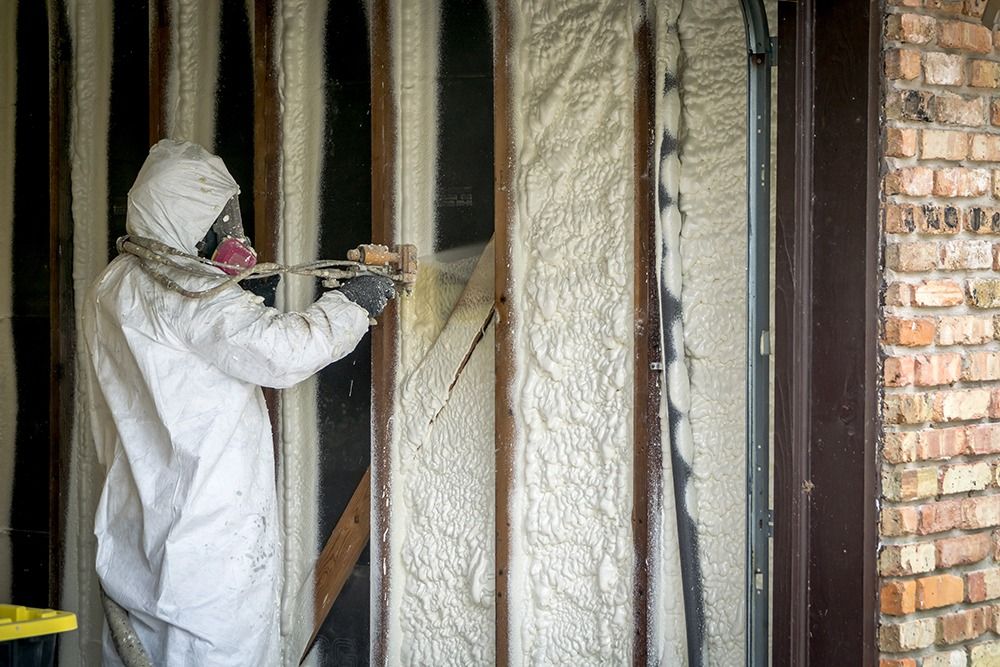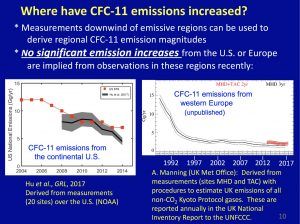Unexpected, unreported, and so far unexplained emissions of CFC-11
By Durwood J. Zaelke, Veerabhadran Ramanathan | September 13, 2018
 Spray foam insulation had been one of the leading causes of the emission of ozone-destroying chemicals known as CFCs. Could the demolition of older homes containing the banned substance be the source of the unexplained increase of CFCs in the atmosphere? Image courtesy Shutterstock
Spray foam insulation had been one of the leading causes of the emission of ozone-destroying chemicals known as CFCs. Could the demolition of older homes containing the banned substance be the source of the unexplained increase of CFCs in the atmosphere? Image courtesy Shutterstock
After detective work worthy of Sherlock Holmes, researchers announced on July 8 that they had pinned down the cause of the recently discovered increase in the chlorofluorocarbon (CFC) known as CFC-11—one of the most potent chemicals causing dangerous holes to form in the ozone layer of the Earth’s stratosphere. (The stratospheric ozone layer is located 10 miles [17 kilometers] above the Earth’s surface in the tropics and 4 miles above the poles, and protects us from the harmful ultraviolet radiation that can cause cataracts, skin cancers, and suppresses our immune systems, among other effects.)
The finger initially was pointed at 18 rogue factories in China that had been using CFC-11 in the manufacture of the spray foam insulation material that they were putting into refrigerators and buildings. They were doing this even though this substance was banned under the Montreal Protocol—which China had signed back in the ‘80s.
Case closed.
Or was it?
Despite initial appearances, things may not be all that clear-cut. Other offending factories, and other sources of these synthetic compounds, may still be out there. The reasons for these suspicions: The numbers don’t add up, and it’s not clear that all of the CFCs are coming from East Asia.
We know this because of the way in which the Montreal Protocol was set up.
The role of the Montreal Protocol. One important tool to making sure that the rules of the Montreal Protocol were followed was that the Protocol was backed up by a worldwide network of monitoring stations, which provide accurate observations of concentrations of CFCs in the atmosphere everywhere on the globe. This network of CFC observations led to the recent discovery of anomalous emissions of CFC-11, reported in the journal Nature by a team of scientists led by Stephen Montzka of the US National Oceanic and Atmospheric Administration. If not stopped quickly, the unexpected, unreported, and so far still not-entirely-explained emissions of CFC-11 threaten to delay recovery of the ozone layer by nearly a decade, and set back the recovery of the Antarctic ozone hole by up to 30 years.
The Montzka team’s study showed that CFC-11 concentrations steadily declined from 1995 to 2002, from a peak of about 350 gigagrams per year (Gg/yr) in the late 1980s—equal to 350,000 metric tons. It then remained constant from 2002 to 2012 at 54 Gg/yr, when the rate of decline was expected to accelerate nearly twice as fast, as the banks of the chemicals embedded in products and equipment declined following the ban, and as parties to the treaty reported that their production of new supplies of CFC-11 was approaching zero. The rate of decline of CFC-11 emissions slowed further from mid-2015—and then started to unexpectedly increase, with reported emissions during 2014-2016 of 67 Gg/yr, an increase of 13 Gg/yr, or roughly 25 percent, from the 2002-2012 emissions levels.
The observed data reported by Montzka’s team suggested that the emissions came from new production in East Asia after the 2010 ban; other data from the United States and the European Union have ruled out these locations as being the sole source of the emissions.

To make matters even more complicated, it turns out that the location of the emissions does not necessarily indicate where the CFC-11 might have been produced. (In other words, the CFC-11 may have been made in one country, but the emissions may come from another country—such as what could conceivably happen if spray foam was made in a factory in China under pristine, highly controlled, hospital-emergency-room clean conditions but used in manufacturing refrigerators in a poorly run factory in another country, to give one purely hypothetical example.)
And researchers are not sure what percentage of the CFC emissions can be laid at the doors of those 18 factories in China, especially as Chinese authorities said that they followed up leads and didn’t find “any large scale” violations. (They first said “no violations” but were pressed by US negotiators to clarify and then said “no large scale” violations.)
Other hypotheses explaining increased CFC-11 emissions. Other explanations besides new CFC-11 production may be possible, but Montzka and colleagues concluded that they are less likely. One possibility is that the increase in CFC-11 emissions could be from an increase in the rate of emissions from old stockpiles and banks of previously (and legally) produced CFC-11. (A “stockpile” consists of chemicals being saved to use later, while a “bank” is chemicals already put into a product such as air conditioners or insulating foams.) But to approach the size of the derived emissions, this would mean a near-doubling of the predicted rate of emissions from previously existing stockpiles and banks, from 3.5 percent to 7 percent per year, primarily from foam insulation. Building-related demolition is unlikely to be the source, as this is expected to be fairly small, and initially from the United States and the European Union, where most CFC-11 was used during the 1970s. It also would have had to accelerate after 2012.
The Montreal Protocol’s Technology and Economic Assessment Panel reported that they were not aware of any new uses of CFC-11 that started or accelerated during that time period, although they reported a number of new patents related to CFC-11 that have been published in the past two years. They also noted that about 2 million metric tons of foam, which is equivalent to one-third of the entire global production of polyurethane rigid foam in 2017, would have had to be destroyed each year to account for the excess emissions of 13 Gg/yr of CFC-11. Alternatively, this would have required the disposal of 13 million US-style, large-size refrigerators (or two-to-four times as many of the smaller ones used in Asia and Europe) every year since 2013. For comparison, the disposal rate in China is reported to be in the range of 1.5 million refrigerators per year.
Another puzzling question concerns the absence of CFC-12 emissions, which have not been increasing alongside CFC-11, although this chemical is unavoidably produced at the same time. Well-operated production can eliminate most of it, with considerably difficulty, although it is not clear how easily this could be done by any rogue factories that might be operating in China or elsewhere.
Finding the reasons for the extra chlorofluorocarbon production are important for a number of reasons. In addition to their well-publicized effect on the ozone layer, chlorofluorocarbons are major contributors to global warming—a fact that is less acknowledged among policy makers until recently, and in the popular press.
As an independent study published by one of us (Ramanathan) in 1975 showed, both CFC-11 and CFC-12 are potent, “super greenhouse gases;” increasing their atmospheric concentrations by a tiny amount of just 2 parts per billion each can warm the planet by as much as 0.9degrees Celsius—an important amount when the Paris Agreement on Climate Changes is struggling to limit further global temperature increases to 1.5 degrees. (To give a sense of the incredible power of CFCs, the warming effect of 2 parts per billion of CFC-11 and CFC-12 is equal to the effects of 65 parts per million of carbon dioxide).
While the Montreal Protocol did not explicitly concern itself with the climate-warming effect of CFCs back when this unique science-policy-governance pact was signed in the ‘80s, by decreasing concentrations of CFCs in the atmosphere, the protocol had the salutary effects of decreasing their super greenhouse warming. This provided a powerful “climate bonus,” avoiding warming that couldotherwise have reached the equivalent of an estimated 24–to-76 metric gigatons of carbon dioxide every year by 2010, thus confirming the Ramanathan-1975 finding of the super greenhouse effect of CFCs.These avoided emissions were cost-effective; a recent paper calculates that donors to the treaty’s funding mechanism paid $0.14 per metric ton of avoided CO2-equivalent in China, compared to $2.90-to-$37.80 per metric ton under the European Emission Trading Scheme. As a result, the Montreal protocol is now recognized as the most successful and effective climate mitigation policy.
(However, in eliminating CFC-11 and CFC-12 from their factory floors, manufacturers substituted other chemicals such as hydrofluorocarbons—which may have been good for the ozone layer but have a strong greenhouse effect [albeit not as large as that of CFC-11 and CFC-12]. If left unchecked, hydrofluorocarbons by themselves could warm the climate by up to 0.5 degrees Celsius by the end of this century.)
So, where does all this leave us?
A teachable moment. The production and use of CFC-11 was banned globally nearly a decade ago under the Montreal Protocol, and Montzka et al.’s finding show the first sustained increase in CFC emissions since production controls began in the late 1980s. The institutions of the Montreal Protocol regime came prepared to address the problem at the treaty’s mid-year meeting in July known as the Open-Ended Working Group. The opening statements noted that we “all have a deep stake in sorting out this issue, in finding the source of the emissions, and abating them.”
The Protocol has a good track record of dealing with new problems such as this one; during its 31 years of operation, the Montreal Protocol has been used to phase out nearly 100 substances that were found to deplete ozone and warm the atmosphere, putting the stratospheric ozone layer on the path to returning to 1980 levels by 2065. The Protocol has been progressively strengthened since it was established, most recently in 2016 with the Kigali Amendment to phase down HFCs, which will avoid most of the 0.5 degrees Celsius the HFC emissions would have caused, and perhaps double this climate benefit if the Parties succeeds in their current efforts to improve the energy efficiency of cooling equipment during the phasedown. The Protocol is the only treaty, environmental or otherwise, to have been ratified by every UN member country.
The Montreal Protocol’s Scientific Assessment Panel is now analyzing the most recent data from monitoring stations in South and East Asia, including South Korea and Japan, to pinpoint the sources of the increased CFC-11 emissions and solve the puzzle.
The United States, along with more than 60 co-sponsors, presented a draft decision on CFC-11 at the Open-Ended Working Group, requesting that the investigation continue, and provide information on potential sources of emissions of CFC-11 from potential production and uses—as well as from stockpiles that may be the source of the unexpected CFC-11 emissions.
Since the July meeting, China has announced a special campaign to identify any illegal CFC-11 production, and local authorities have already filed charges against two of the firms found to be producing CFC-11 and CFC-12. (These actions are in line with China’s earlier efforts to prosecute illegal CFC-11 production, going back several years.)
A subsequent editorial in Nature reported that this issue apparently has received the personal attention of President Xi Jinping. China has since underscored its policy of “zero tolerance” on production and use of CFC-11. In July, its Plastics Processing Industry Association officially announced that it had launched an “Initiative on Consciously Rejecting Illegal Foaming Agents,” which suggests that the Chinese-government had encouraged sectors linked to the CFC-11 issue to ensure compliance. At the beginning of August, the country’s Ministry of Ecology and Environment launched what it called a Special Campaign on Ozone-Depleting Substance Enforcement to “comprehensively investigate key national industries and enterprises.” (Link in Chinese.) Also in August, several Chinese provinces and municipalities announced efforts in support of the Special Campaign.
Lessons learned for climate mitigation. Climate change, if left unchecked, can become dangerous within a decade or two, affecting billions with deadly heat waves, floods and droughts, making it an existential risk as initial warming sets off self-reinforcing feedbacks that can fall like dominoes.
On the bright side, the Nature study was only published in May 2018—but within two months, parties to the Montreal Protocol and the institutions of their treaty started responding to locate and mitigate the anomalous emissions. How was that possible? We ascribe this to unimpeachable scientific data, and 30-plus years of a successful public-private partnership between the science community, policy makers, parties, and private industry. The network of calibrated monitoring stations for CFCs must be given the top credit for helping sustain this partnerships.
Similar unimpeachable networks of calibrated monitoring stations must be set up for major climate warming pollutants such as carbon dioxide, methane, black carbon, and tropospheric ozone. Networks exist but are not globally adequate. For example, the carbon dioxide data still has more than 5 percent uncertainty; methane has an uncertainty of at least 15 percent or more; and black carbon emission inventories are uncertain by 50 percent or more. We are not claiming that improving the accuracy of monitoring of the emissions of climate pollution will by itself overcome the current impasse in climate mitigation actions. But it is a necessary ingredient for effective climate mitigation policies.
Fast and sustained action is needed by the Parties and the Montreal Protocol regime to ensure that the treaty gets back on track to phase out CFC-11 and repair the stratospheric ozone layer on schedule. When he opened the Open-Ended Working Group meeting in July, Austria’s Secretary-General of the Ministry of Sustainability and Tourism, Josef Plank, stated that while the responses to the unexpectedly high CFC-11 emissions “clearly demonstrate the functioning of established implementing and surveillance tools of the Protocol, …[i]t could further be seen as an opportunity to refine the implementation strategies of the Montreal Protocol with a view to make the system even more effective.”
The Montreal Protocol has had violations in the past, and always worked successfully to correct them. The size of the current emissions, however, suggests the need to further strengthen the monitoring and compliance assurance mechanisms to identify violations at the earliest possible time, and to correct them as quickly as possible. In addition, it also will be important to re-evaluate the assumptions for stockpiles and banks, including their leak rates.
Together, we make the world safer.
The Bulletin elevates expert voices above the noise. But as an independent nonprofit organization, our operations depend on the support of readers like you. Help us continue to deliver quality journalism that holds leaders accountable. Your support of our work at any level is important. In return, we promise our coverage will be understandable, influential, vigilant, solution-oriented, and fair-minded. Together we can make a difference.
Keywords: CFCs, chlorofluorocarbons, climate change, ozone hole, ozone layer
Topics: Analysis, Climate Change















